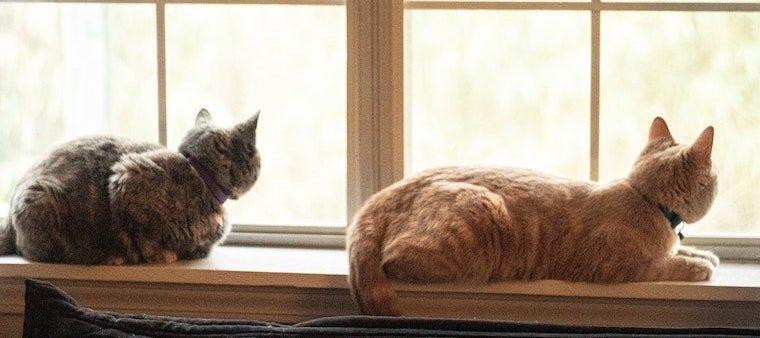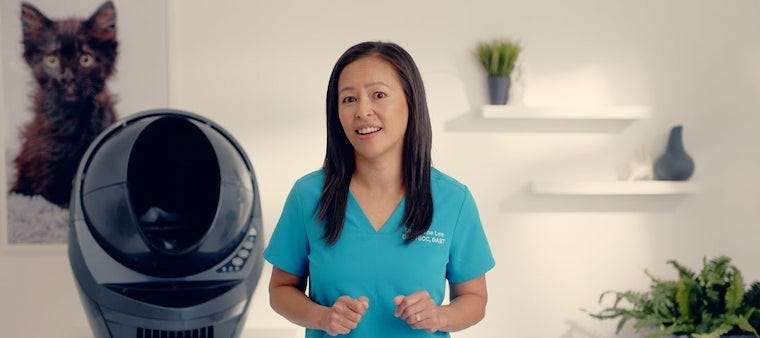What is FIV? As an emergency critical care veterinary specialist, I’m often shocked that cat owners don’t know their cat’s “FIV” (Feline Immunodeficiency Virus) or “FeLV” (Feline Leukemia) status when they come into the ER. To me, that’s the equivalent of not knowing if your boyfriend or partner has HIV or AIDS.
Why? Because FIV and FeLV are very contagious (thankfully only to cats, not you). And if you have another cat in your household, it risks and potentially shortens your other cat’s life.
For me? My general rule is that any cat that you adopt, purchase, or rescue should always be tested for these two infectious diseases before you even let them see your other cats. This is important, so as to keep your other cats safe.
Facts about Feline Immunodeficiency Virus (FIV)
So, what do you need to know about FIV?
What is FIV?
Feline Immunodeficiency Virus, more often called FIV, is a contagious virus that affects the immune system. The FIV virus spreads through the body and reproduces in the T-lymphocyte (e.g., white blood cells). It affects and spreads to the lymph nodes, and can rapidly progress. Similar to HIV, it makes a cat more at risk for getting infections and more immunosuppressed. Just as people can live with HIV for years, inevitably it progresses to AIDS. Likewise, FIV cats can live with this infectious disease for years; however, they will ultimately succumb to death from the disease or secondary infection. While normal healthy cats can fight off bacteria, viruses, and parasitic infections, immunosuppressed cats with FIV end up succumbing to these diseases.
FIV is seen more commonly in cats that go outside, are young, and are male. It’s estimated that 2.5 million cats are affected by FIV worldwide.
FIV is more prevalent in the Asia Pacific region of the world. In the United States, it’s estimated that approximately 1.5-3% of healthy cats are FIV-positive. You heard me correctly—some cats can be healthy and live with FIV for years, especially with frequent veterinary care. However, in unhealthy cats (e.g., those that present sick to a veterinarian), rates are estimated to be approximately 15%.
How is FIV spread?
FIV spreads from cat to cat by fighting. Transmission occurs primarily through saliva, but it can also pass via blood, placental transfer, or sexual transmission. While it is contagious, cats that live peacefully together (without fighting) are less likely to spread it to each other. So, what does this mean? What is FIV prognosis? If one of your cats is diagnosed with FIV, he likely can still live peacefully with your other cats, as long as you keep him or her inside, and your cats get along. Again, FIV is not infectious to humans.
Unfortunately, cats that are affected by FIV end up developing inflammation of their body. They get severe inflammation of their gums (e.g., gingivitis) and mouth (e.g., stomatitis), neurologic signs (behavioral changes, seizures, etc.), gastrointestinal disease (e.g., diarrhea), immune-mediated problems, and recurrent infections of the eyes, upper respiratory tract, skin, and even renal system.
How do we diagnose FIV?
There are several blood tests for FIV and FeLV, with the most commonly run FIV test done in veterinary clinics being an ELISA test; this is automatically combined with a blood test for Feline Leukemia (FeLV). The FIV ELISA tests for antiviral antibodies, while the FeLV tests for the presence of FeLV or its antigens. Why is this important to know? Because kittens that have been exposed to their mom’s blood may test FIV-positive, but may “seroconvert” to FIV-negative several months to years later. Kittens that test positive should be tested every 6 months for several years to confirm if they have FIV.
How can I prevent my cat from getting FIV?
The best way to prevent your cat from getting FIV is by screening and testing all cats in your household at your veterinarian. Before you bring a new cat in the household, this common FIV and FeLV test is a must do. If your cats are negative, great!
The next safest thing is to keep your cats indoors to prevent fighting with a stray neighborhood cat that may carry the disease.
What if my cat was just diagnosed with FIV?
If your cat was just diagnosed with FIV, don’t fret. Again, cats can live with this type of disease for years (as compared to FeLV). That said, a twice-a-year veterinary visit is a must—the sooner your veterinarian can detect inflammatory changes in your cat (in the skin, eyes, etc.), the sooner we can treat it and help make your cat more comfortable. Learn more about how long FIV+ cats live.
Facts about Feline Leukemia Virus (FeLV)
Now let's take a look at FeLV.
How are FIV and FeLV different?
FIV and FeLV have some very important differences. Feline Leukemia (FeLV) is much more devastating than FIV. This is because FeLV typically results in cancer (e.g., lymphoma), leukemia (e.g., cancer of the bone marrow or circulating white and red blood cells), and severe bone marrow suppression (e.g. anemia) in young cats.
Cats that are FeLV-positive only live with the disease for a few years, as compared to cats with FIV. Cats can live with FIV for a much longer period of time (even up to a decade or more), provided their other infections/inflammation of the body can be treated.
What is FeLV?
Feline leukemia is caused by a highly contagious retrovirus that affects your cat’s bone marrow and immune system (e.g., the lymphoid organs like the lymph nodes, thymus, spleen). Once this virus affects your cat’s body, it can result in cell mutation, cancer (such as lymphoma), and direct effects on the number of white and red blood cells in your cat’s body.
Some cats are more at risk for FeLV: male cats and those that have outdoor access. Clinically, I also see kittens at higher risk for FeLV, as their immune system is weaker and more immature (due to their age). Kittens may have innocently gotten the infection from their mother.
How is FeLV spread?
Unfortunately, feline leukemia is very contagious to other cats—especially from bite wounds or prolonged close contact to a FeLV+ cat. Cats get FeLV predominantly through bodily fluids such as saliva, milk, respiratory or nasal secretions, placental transfer, urine, blood, and, rarely, feces.
Learn more about how FeLV is spread and its symptoms.
How do we diagnose FeLV?
Testing for FeLV/FIV is a MUST DO before your new cat steps one paw into your household. Why? Again, because this virus is so infectious—and I don’t want to expose any other house cats to it.
The test for FeLV is a simple blood test. There are several types of blood tests, including the ELISA, IFA, and PCR. The most common blood test for FeLV is the ELISA test, which is readily available at any veterinary clinic or animal shelter. This test is very accurate and inexpensive to run, and you can get results back within minutes.
If your kitten or cat tests negative for FeLV, that’s great news—a negative test is very reliable. If your kitten or cat tests positive for FeLV, your veterinarian will need to send out different blood tests—the IFA or PCR—to confirm the diagnosis. These are more specific tests that test for specific parts of the FeLV retrovirus or more advanced disease.
How can I prevent my cat from getting FeLV?
Here are the top three ways to prevent your cat from getting FeLV:
- Test all cats in your household for FeLV/FIV at your veterinarian. Again, before you bring a new cat into the household, this common FeLV/FIV test is a must do.
- Keep ALL your cats indoors. If you only let one of your five cats out, you’re still exposing the other four cats to infection!
- Get the FeLV vaccine. This vaccine is a must for all kittens and cats that go outside. While the FeLV vaccine is safe, it’s considered a non-core vaccine—in other words, not all adult cats need it as they age and mature. Also, keep in mind that the FeLV vaccine is not 100% protective (as compared to other feline vaccines, which are almost 99% effective).
What if my cat was just diagnosed with FeLV?
If your cat was just diagnosed with FeLV, first, my heart goes out to you. It’s a devastating disease and can be very stressful to deal with.
Cats diagnosed with FeLV should be kept indoors at all times to prevent the spread to other cats. If you have other cats in the household, disinfect water and food bowls, kitty litter boxes, etc., with a dilute bleach solution or disinfectant. Then, isolate your FeLV+ cat from your other cats to prevent exposure.
Keep your FeLV+ cat as healthy as possible with physical examinations 2-4x a year, preventative medication, and blood work monitoring. If you notice any clinical signs—like pale gums, not eating, difficulty breathing, and weight loss—seek veterinary attention immediately for treatment, since your cat will need more care for their weakened immune system. There are some treatments for specific problems—like antibiotics for an infection, fluids under the skin for dehydration, appetite stimulants for loss of appetite, and blood transfusions for anemia—but there is no direct cure for FeLV.
Learn more about living with FeLV+ cats.
When in doubt, talk to your veterinarian about any concerns related to these two feline viruses.






